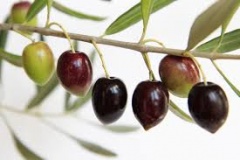Olives
| Infobox on Olives | |
|---|---|
| Example of Olives |  |
| Facts | |
| Origin | Mediterranean countries |
| Stowage factor (in m3/t) | 1,50/1,84 m2/t (barrels) |
| Humidity / moisture | - |
| Ventilation | - |
| Risk factors | See text |
Olives
Description
The olive tree is a small tree. Its scientific name is Olea europaea. A long time ago, it came from the coastal areas of the eastern Mediterranean, from Syria and the maritime (next to the sea) parts of Asia Minor and northern Iran at the south end of the Caspian Sea. It has been farmed for a very long time. The Ancient Greeks were farming it. They spread the trees to the western part of the Mediterranean.
Olive trees like soil with lots of chalk in it. They grow best on limestone slopes and crags in coastal climate.
The Wild Olive is a small tree or shrub that grows up to 8–15 m tall with thorny branches. The leaves are opposite, 4–10 cm long and 1–3 cm wide. The leaves have a dark greyish-green colour above and are pale with whitish scales below. The small white flowers, with calyx and corolla divided into four parts, two stamens and bifid stigma, are mostly on the last year's wood, in racemes coming up from the axils of the leaves. The fruit is a small drupe 1–2 cm long, thinner-fleshed and smaller in wild plants than in orchard cultivars.
The olive (Olea europaea) is the fruit of the olive tree or "oliver". It is an important food crop in Italy, Spain and especially in Greece among other countries around the Mediterranean. It is naturally very bitter, but after a long time in salt, it becomes a tasty and healthy food (though very fatty - it is one of the fattiest cooking oils in use, even more than palm, canola and other vegetable oils). Olive oil is the juice made by crushing olives.
The olive is a drupe, or stone fruit, like a plum or cherry. Olives start out green and very bitter and turn black when they mature. Different varieties of olives are usually picked at different points in the development of the fruit. Green olives generally have more Vitamin E and less oil than black olives, which have a stronger flavour and more oil. Most green olives are eaten whole rather than made into oil. Only 10 percent the olive crop is eaten as olives. Most is made into oil
Application
Today, olive trees are grown for the following reasons:
1.The fruit of the tree is used:
- For cooking. Directly from the tree the olive does not taste very good (it tastes very bitter). It is put into some liquid that makes it less bitter. When this is done, it can be used in many recipes of Mediterranean cooking.
- To make olive oil. This is a very important vegetable oil.
2. The wood of the tree is very hard. It is used to make furniture or articles of everyday use.
3. The leaves of the tree have some medical uses. It is said that the leaves have a calming effect. They are good for people going to sleep. They are also good for the immune system and to bring down high levels of cholesterol. The oil is good for the cardiovascular system (the heart, and the arteries, etc.) and the circulation of fat in the body.
Shipment / Storage / Risk factors
Shipped in kegs or drums. Olives arriving with a shriveled appearance due to the loss of brine in which they are shipped should be replenished with brine of proper strength and allowed to stand for about three weeks; the olives may then recover their normal appearance. The success of this method depends on the length of time the olives have remained without brine and their freedom from mould growth. If besides being shriveled they are blackened in appearance, the renewal of the brine may not have any effect. A white deposit is not indicative of damage due to external causes, but may result from incomplete fermentation during pickling. Subject to bacterial decomposition, which is usually evidence by an offensive odour. Leaky containers will cause the development of scum on top of the liquid in which the olives are contained.











